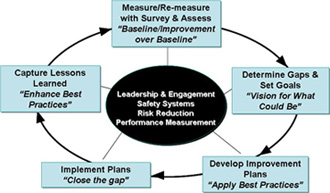Not all Employers are the same and neither are the results of their risk management efforts. High performing companies follow these 5 key strategies.
- First is safety intervention, that is, the attempt to prevent injuries from happening at all (measured as Safety Diligence, Ergonomic Solutions, and Safety Training).
- Second is disability management, the set of strategies to minimize the disability consequences of a given injury or disease arising from the workplace (measured as Disability Case Monitoring and Proactive Return-to-Work Program).
- Third is health promotion, which represents an attempt to intervene directly with individuals to encourage more healthy lifestyles, in the expectation that this will reduce the likelihood of a workplace accident or disease, or reduce the lost work time resulting from a given injury or disease (measured as Wellness Orientation).
- Fourth is the general environment of the firm and the orientation of its management in areas measured as People Oriented Culture and Active Safety Leadership.
- Fifth is the implementation, measurement and adjustment of the first four.
Disability can be managed and those who do it well can expect to be rewarded with lower disability costs, more satisfied workers, higher productivity and, ultimately, higher profits.

